SLOS704B January 2011 – August 2015 TPA6138A2
PRODUCTION DATA.
- 1 Features
- 2 Applications
- 3 Description
- 4 Revision History
- 5 Device Comparison Table
- 6 Pin Configuration and Functions
- 7 Specifications
- 8 Parameter Measurement Information
- 9 Detailed Description
- 10Application and Implementation
- 11Power Supply Recommendations
- 12Layout
- 13Device and Documentation Support
- 14Mechanical, Packaging, and Orderable Information
Package Options
Mechanical Data (Package|Pins)
- PW|14
Thermal pad, mechanical data (Package|Pins)
Orderable Information
7 Specifications
7.1 Absolute Maximum Ratings
over operating free-air temperature range (unless otherwise noted)(1)| MIN | MAX | UNIT | |
|---|---|---|---|
| VDD to GND | –0.3 | 4 | V |
| Input voltage, VI | VSS – 0.3 | VDD + 0.3 | V |
| Minimum load impedance – line outputs – OUTL, OUTR | 12.8 | Ω | |
| Mute to GND, UVP to GND | –0.3 | VDD +0.3 | V |
| Maximum operating junction temperature range, TJ | –40 | 150 | °C |
| Storage temperature range, Tstg | –40 | 150 | °C |
(1) Stresses beyond those listed under Absolute Maximum Ratings may cause permanent damage to the device. These are stress ratings only, and functional operation of the device at these or any other conditions beyond those indicated under Recommended Operating Conditions is not implied. Exposure to absolute-maximum-rated conditions for extended periods may affect device reliability.
7.2 ESD Ratings
| VALUE | UNIT | |||
|---|---|---|---|---|
| V(ESD) | Electrostatic discharge | Human body model (HBM), per ANSI/ESDA/JEDEC JS-001(1) | ±4000 | V |
| Charged-device model (CDM), per JEDEC specification JESD22-C101(2) | ±1500 | |||
(1) JEDEC document JEP155 states that 500-V HBM allows safe manufacturing with a standard ESD control process.
(2) JEDEC document JEP157 states that 250-V CDM allows safe manufacturing with a standard ESD control process.
7.3 Recommended Operating Conditions
| MIN | NOM | MAX | UNIT | |||
|---|---|---|---|---|---|---|
| VDD | Power supply | DC supply voltage | 3 | 3.3 | 3.6 | V |
| RL | Load impedance | 16 | 32 | Ω | ||
| VIL | Low-level input voltage | Mute | 40 | %VDD | ||
| VIH | High-level input voltage | Mute | 60 | %VDD | ||
| TA | Ambient temperature | –40 | 25 | 85 | °C | |
7.4 Thermal Information
| THERMAL METRIC(1) | TPA6138A2 | UNIT | |
|---|---|---|---|
| PW (TSSOP) | |||
| 14 PINS | |||
| RθJA | Junction-to-ambient thermal resistance | 130 | °C/W |
| RθJC(top) | Junction-to-case (top) thermal resistance | 49 | °C/W |
| RθJB | Junction-to-board thermal resistance | 63 | °C/W |
| ψJT | Junction-to-top characterization parameter | 3.6 | °C/W |
| ψJB | Junction-to-board characterization parameter | 62 | °C/W |
(1) For more information about traditional and new thermal metrics, see the Semiconductor and IC Package Thermal Metrics application report, SPRA953.
7.5 Electrical Characteristics
VDD = 3.3 V, RDL = 32 Ω, Rfb = 30 kΩ, RIN = 15 kΩ, TA = 25°C, Charge pump: CP = 1 µF (unless otherwise noted)| PARAMETER | TEST CONDITIONS | MIN | TYP | MAX | UNIT | |
|---|---|---|---|---|---|---|
| |VOS| | Output offset voltage | VDD = 3.3 V | 0.5 | 1 | mV | |
| PSRR | Power-supply rejection ratio | 80 | dB | |||
| VOH | High-level output voltage | VDD = 3.3 V | 3.1 | V | ||
| VOL | Low-level output voltage | VDD = 3.3 V | –3.05 | V | ||
| VUVP_EX | External UVP detect voltage | 1.25 | V | |||
| VUVP_EX_HYSTERESIS | External UVP detect hysteresis current | 5 | µA | |||
| fCP | Charge-pump switching frequency | 200 | 300 | 400 | kHz | |
| |IIH| | High-level input current, Mute | VDD = 3.3 V, VIH = VDD | 1 | µA | ||
| |IIL| | Low-level input current, Mute | VDD = 3.3 V, VIL = 0 V | 1 | µA | ||
| IDD | Supply current | VDD = 3.3 V, no load, Mute = VDD, no load | 5 | 14 | 25 | mA |
| VDD = 3.3 V, no load, Mute = GND, disabled | 14 | |||||
7.6 Operating Characteristics
VDD = 3.3 V, RDL = 32 Ω, Rfb = 30 kΩ, RIN = 15 kΩ, TA = 25°C, Charge pump: CP = 1 µF (unless otherwise noted)| PARAMETER | TEST CONDITIONS | MIN | TYP | MAX | UNIT | |
|---|---|---|---|---|---|---|
| PO | Output power, outputs in phase | THD+N = 1%, VDD = 3.3 V, f = 1 kHz, RL = 32 Ω | 40 | mW | ||
| THD+N | Total harmonic distortion plus noise | VDD = 3.3V, f = 1kHz, RLD = 32Ω, Po = 10mW | 0.01% | |||
| SNR | Signal-to-noise ratio(1) | A-weighted | 90 | 96 | dB | |
| DNR | Dynamic range(2) | A-weighted | 90 | 100 | dB | |
| VN | Noise voltage | A-weighted | 13 | μV | ||
| ZO | Output Impedance when muted | Mute = GND | 110 | mΩ | ||
| Input-to-output attenuation when muted | Mute = GND | 80 | dB | |||
| Crosstalk—L to R, R to L | Po = 20 mW | –75 | dB | |||
| ILIMIT | Current limit | PVDD = 3.3 V | 50 | mA | ||
(1) SNR is calculated relative to 25-mW output.
(2) DNR is calculated relative to output at 1% THD+N.
7.7 Typical Characteristics
VDD = 3.3 V , TA = 25°C, C(PUMP) = C(VSS) = 1 μF , CIN = 2.2 μF, RIN = 15 kΩ, Rfb = 30 kΩ, ROUT = 10 Ω, COUT = 1 nF (unless otherwise noted)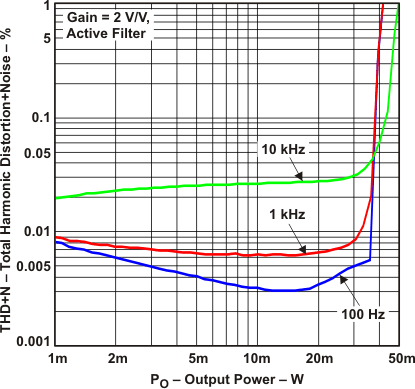
| VDD = 3.3 V, | RL = 32 Ω |
vs Output Power
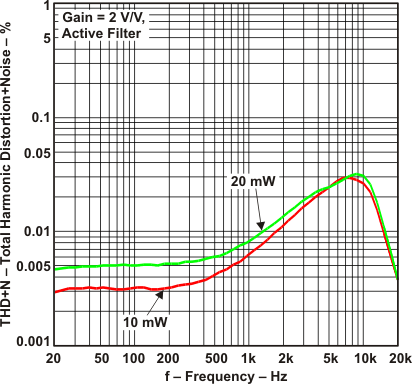
| VDD = 3.3 V, | RL = 32 Ω |
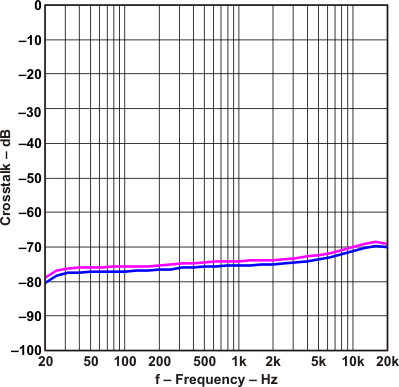
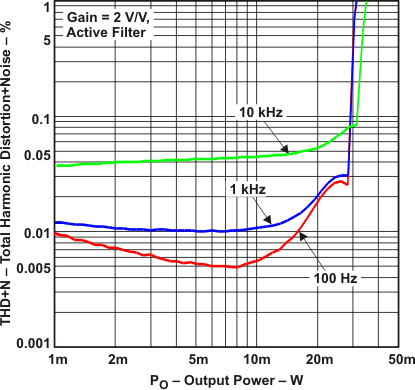
| VDD = 3.3 V, | RL = 16 Ω |
vs Output Voltage
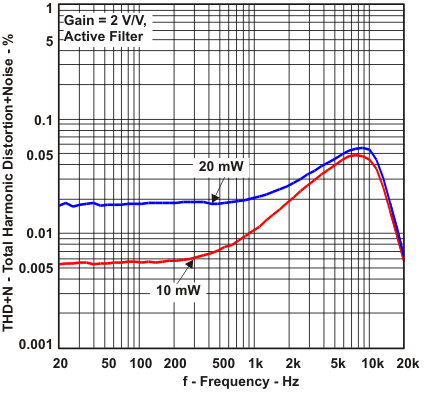
| VDD = 3.3 V | RL = 16 Ω |
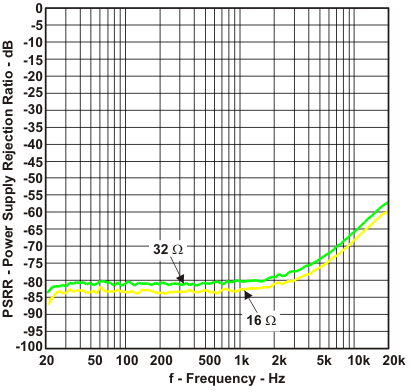
| Gain = 6dB | Vripple = 200 mVpp |